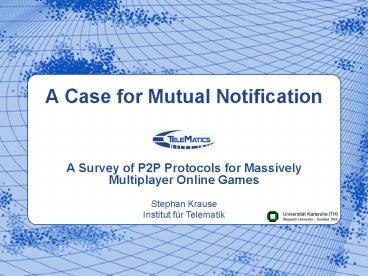A Case for Mutual Notification PowerPoint PPT Presentation
Title: A Case for Mutual Notification
1
A Case for Mutual Notification
- A Survey of P2P Protocols for Massively
Multiplayer Online Games
2
MMOGs in the wild
- All use a client/server architecture
- Almost all use sharding
3
P2P-MMOG
- Use the power of P2P to overcome scalability
issues - Research topic for quite some time
- Plethora of protocols
- Which architecture is the best?
4
Classification
- Too many protocols to look at all of them
- Focus on protocols for MMO(RP)Gs
- Identify classes of protocols
- Looking at
- Division of game space
- Exchanging movement messages
- Resulting classes
- ALM-based Protocols
- Supernode-based Protocols
- Mutual Notification Protocols
5
ALM
- Divide game space into subspaces
- Usually fixed size, fixed ID
- Create a multicast group for each subspace
- Players have a certain Area of Interest (AoI)
- Subscribe to all subspaces inside their AoI
- Max 4 rectangular subspaces
- Unsubscribe if player moves away from subspace
6
SimMUD
- Based upon SCRIBE
- ALM protocol on top of a DHT
- Best for SCRIBE Pastry
- Forming of groups recursively on JOIN
- No additional messaging overhead
- Finding rendezvous points
- Group ID is the hash of the subspace ID
- Root of ALM tree Node closest to the group ID
- Root can be cached
- Failure resistance
- Children detect failure of parents
- Simple reJOINing the group repairs the tree
7
Supernode
- Subspace concept similar to ALM-based
- AoI/subscription-/unsubscription rules apply
- Subspaces can be static or dynamic
- Supernode responsible for each subspace
- With dynamic subspaces
- If too many players in subspace, divide it
- With static subspaces
- Additional load balancing mechanism needed
8
PubSubMMOG
- Static subspaces
- Central lobby server for resource allocation
- Assigns roles
- Supernode
- stores all information for the subspace
- Backup node
- If supernode fails, backup node takes over
- Load balancing tree
- Timeslots
- Supernode aggregates messages from a timeslot
- Problem limits maximum latency
9
Mutual Notification
- No fixed subspaces
- Players exchange messages directly
- Guarantees good latency overhead
- Connection to all players in AoI
- Players must know all their neighbors
- Neighbors help discovering moving players
- Neighbor discovery must be reliable
10
VAST
- Voronoi-based Adaptive Scaleable Transfer
- Each player computes Voronoi diagram of all known
neighbors - Neighbor types
- Enclosing neighbors
- Boundary neighbors
- Movement
11
Simulation
- OverSim as simulation framework
- Easy simulation of overlay and P2P networks
- Realistic models for user behavior
- Churn model
- Pareto distributed lifetimes
- Mean lifetime 100 minutes
- On average 500 nodes
- Delay
- Real internet data
- Using measurements from CAIDAs skitter project
- Simulated time 2 hours
12
Simulation
- Player behavior modeled by simple game client
- In-game movement model
- Random waypoint
- Speed 5m/s
- Players can form groups, flocking
- AoI 40m
- 1010 subspaces
- 5 movement updates/sec
- PubSubMMOG 2/sec due to latency limitations
13
Scenarios
- Most important factor player density
- Global density
- Number of players/game area
- Playground sizes
- 1,0001,000, 5,0005,000, 10,00010,000
- Local density
- Local clustering of players
- Modeled with groups
- Group sizes
- 1,5,15,25,40
14
Results Delay (10,00010,000)
15
Results Delay (5,0005,000)
16
Results Delay (1,0001,000)
17
Summary Delay
- SimMUD
- Robust to local density
- Problems with global density
- PubSubMMOG
- Robust to global density
- Logarithmic increase with local density
- VAST
- Robust to both global and local density
18
Results Bandwidth (10,00010,000)
19
Results Bandwidth (5,0005,000)
20
Results Bandwidth (1,0001,000)
21
Summary Bandwidth
- SimMUD
- Robust to local density
- Problems with global density
- PubSubMMOG
- Affected by both global and local density
- Traffic can get rather high
- VAST
- In most cases, unaffected to both global and
local density - Only increases in really crowded settings
22
Conclusions
- Best delay VAST
- Can be generalized to all mutual notification
protocols - Best bandwidth
- Low player densities PubSubMMOG or SimMUD
- High player densities VAST
- Mutual notification great performance
- Stability can be an issue
- ALM rock solid, but high delays
- Supernode stable, good delays, but high
bandwidth - Timeslots unsuitable for globally distributed
players

